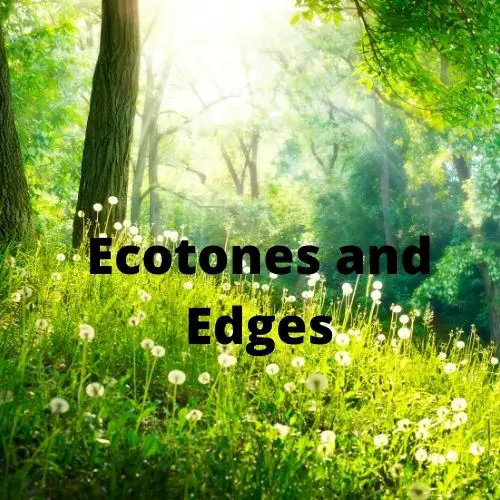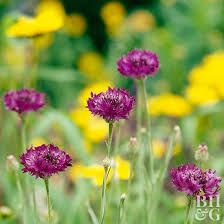We tend to spend a lot of time in the garden. Have you ever wondered why weeds grow stronger and thicker at the edge of the garden path or bed? Do you notice that the edge of stream bed appears lush and fertile while only a few metres away it may be dry and lifeless?
What is an Ecotone Edge?
Ecotones can be defined in a variety of ways (James H Thorpe 2015), but in essence, they are a blending, or dynamic boundaries or transitional areas between two very distinct ecological habitats containing different communities. For example, in land-based systems ecotones are usually located between habitat patches or ecosystems, such as forest to grassland, whereas in aquatic systems, a major ecotonal transition is between land and water. These areas are sometimes considered to be dynamic zones of interaction between communities, which are unstable over time (Kent et al., 1997). It is now commonly accepted, thanks to the work of Odon and others, the concept of an ecotone assumes the existence of active interaction between two or more ecosystems with properties that do not exist in either of the adjacent ecosystems. Ecotonal regions show a diversity of boundary types that range from natural boundaries (e.g., altitudinal and latitudinal transitions) to human-generated ecotones, sometimes termed anthropogenic ecotones. By definition they are far from being a simple edge!
Why are Ecotone Edges Important?
Magic happens in the margins. Consider two populations one male and one female. The coming together of these two populations generally speaking will produce a third population – the offspring. This is a simplified explanation but it shows that ecotone as previously stated creates a diversity that did not exist until the convergence.

In permaculture we recognize that margins or edges can and do produce a transition and can be used to our advantage. David Holmgren wrote in his book Principals and Pathways 2002, that only a limited number of species (both plant and animal) can thrive in an area of shallow, compacted and poorly drained soil that has insufficient edge. (italics mine) However, if we seek to expand the edges and margins, to develop ecotones and increase living soil by default we increase diversity and value the edges and margins more. Travelling the most common, obvious and popular path may lead us in the same direction as all others but it will not lead us to diversity or sustainability. This can be seen in modern agriculture and its use of heavy tilling and chemical fertilisers, pesticides and herbicides. It is the common path but it has created a lot damage with loss of habitat, soils, erosion and runoff affecting the world.
The importance of ecotones, edges, margins and even the marginal is they provide a zone of transition, a zone of diversity, a zone of added life. So how then do we develop and value our edges.
How does Permaculture Use Ecotone Edges?
Permaculture is not unique in its adaptation of edge use, nor was it the first to recognise that this is where the action or magic happens. Nature has of its self and in its self been using the edges for millenia. Consider a tree, how many edges are there? What magic is happening?

The tree roots have surprisingly little mass but enormous surface area or edge. It is at these edges that osmotic pressure absorbs water and minerals from the soil, but also an interchange exists between the organisms, microorganisms, and fungi that is not a one way exchange. The tree does not simply take from its environment but rather exchanges sugars for nutrients with the lifeforms within the soil. They depend on each other for life and thrive in each others presence. But what of the upper portion of the tree? Can you see the interactions – the margins that are created by the those interactions! There is the multiple co-relationships at every level.
At the beginning of this post I asked the question have you ever wondered why the weeds grow thickest and strongest at the edges of your garden beds. The ecotone that is created by the steep change of garden bed to path creates a specific opportunity. Water runs off from both the path and garden bed and lands right there in the edge. Not only that but any fertility in the form of fertiliser also lands there. Particles of decomposing leaf matter, insects, etc all conspire in this spot to provide an ideal breeding ground. Now what if we beat the weeds to it and use our edges for further planting of vegetables or herbs, maybe even some snacking fruits like strawberries or ground cherry.
Examples of Edge Use
We have all seen images of small English Fields with rock fences or hedges used as fences. These were all very carefully planned and maintained edges. Permaculture encourages us to use our edges to perform multiple functions. So the hedgerow may be edible, it produces food either for us or our animals, it acts as a fence to keep our animals in or others out. It also acts as a double forest edge intersecting crops and pastures. They were often planted in drainage channels or on the banks of streams to assist with erosion. Unfortunately, not many of these small English Fields still exist and more is the pitty. They have been removed to make way for larger scale agriculture and urban sprawls and in so doing the complexity of edges has gone as well.

When considering edges we must also think of function as aluded to above. The outputs of one element must feed another in order for it to be self sustaining. Each element should support many other elements or at the very least support one other element in multiple ways. This is were function stacking comes into our design process. Let’s take a look at some other examples, but if you would like to know more about function stacking here is an article we wrote about it.


As you can see the species overlap in the transition zone is varied and diverse. If we use this concept in our designing of houses and increase our edge effect how much more rich a life would we live. Now I understand that not everyone can or even wants to live this close to nature. The reality is most of the worlds population lives in city areas full of concrete and asphalt. There are still many things you can do to increase the diversity in your immediate area. Try adding a small pond to your yard – add some grassy plants and within a short period you will have frogs, insects and birdlife frequenting your garden. Boom the diversity of nature has entered the suburbs.
You may only have a small space and that is totally ok. Check out this post on maximizing small spaces.



